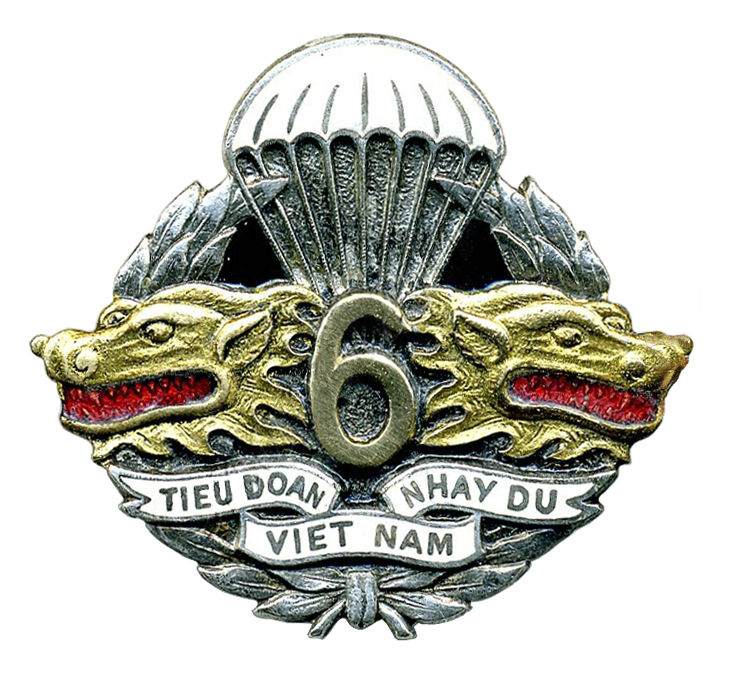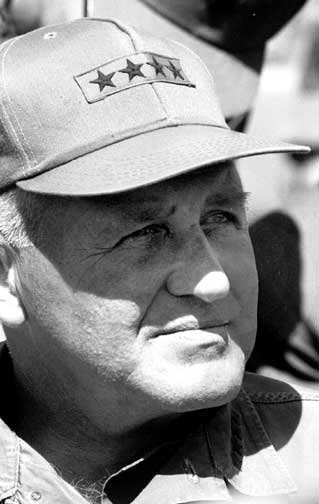|
Republic Of Vietnam Marine Division
The Republic of Vietnam Marine Division (RVNMD, vi, Sư Đoàn Thủy Quân Lục Chiến QLC was part of the armed forces of South Vietnam. It was established by Ngo Dinh Diem in 1954 when he was Prime Minister of the State of Vietnam, which became the Republic of Vietnam in 1955. The longest-serving commander was Lieutenant General Le Nguyen Khang. In 1969, the VNMC had a strength of 9,300, 15,000 by 1973, and 20,000 by 1975. The Marine Division trace their origins to French-trained Commandos Marine divisions recruited and placed under the command of the French Navy but officially incorporated in 1960. From 1970 onwards, the South Vietnamese Marines and Airborne Division grew significantly, supplanting the independent, Central Highlands based Vietnamese Rangers as the most popular elite units for volunteers. Along with the Airborne, the Marine Division formed the General Reserve with the strategic transformation under Vietnamization, with elite and highly-mobile units meant ... [...More Info...] [...Related Items...] OR: [Wikipedia] [Google] [Baidu] |
Marines
Marines, or naval infantry, are typically a military force trained to operate in littoral zones in support of naval operations. Historically, tasks undertaken by marines have included helping maintain discipline and order aboard the ship (reflecting the pressed nature of the ship's company and the risk of mutiny), the boarding of vessels during combat or capture of prize ships, and providing manpower for raiding ashore in support of the naval objectives. In most countries, the marines are an integral part of that state's navy. The exact term "marine" does not exist in many languages other than English. In French-speaking countries, two terms exist which could be translated as "marine", but do not translate exactly: and ; similar pseudo-translations exist elsewhere, e.g. in Portuguese (). The word ''marine'' means "navy" in many European languages such as Dutch, French, German, Italian and Norwegian. History In the earliest day of naval warfare, there was little di ... [...More Info...] [...Related Items...] OR: [Wikipedia] [Google] [Baidu] |
Ngo Dinh Diem
Ngô Đình Diệm ( or ; ; 3 January 1901 – 2 November 1963) was a South Vietnamese politician. He was the final prime minister of the State of Vietnam (1954–1955), and then served as the first president of South Vietnam (Republic of Vietnam) from 1955 until he was captured and assassinated during the 1963 military coup. He was born into a prominent Catholic family, the son of a high-ranking civil servant, Ngô Đình Khả. He was educated at French-speaking schools and considered following his brother Ngô Đình Thục into the priesthood, but eventually chose to pursue a civil-service career. He progressed rapidly in the court of Emperor Bảo Đại, becoming governor of Bình Thuận Province in 1929 and interior minister in 1933. However, he resigned the latter position after three months and publicly denounced the emperor as a tool of France. Diệm came to support Vietnamese nationalism, promoting an anti-communist and anti-colonialist " third way" op ... [...More Info...] [...Related Items...] OR: [Wikipedia] [Google] [Baidu] |
RVN MC , a Dutch footballer
{{Disambiguation ...
RVN can stand for: * CBN (Australian TV station), which had this callsign for it’s Riverina station until 1991 * Registered Veterinary Nurse in the UK * Republic of Vietnam, a former state in southern Vietnam * Rovaniemi Airport, in Finland * Ruud van Nistelrooy Rutgerus Johannes Martinus van Nistelrooij (anglicised to Van Nistelrooy; born 1 July 1976) is a Dutch professional football coach and former player. He is currently the coach of PSV Eindhoven. A former footballer, Van Nistelrooy is often consi ... [...More Info...] [...Related Items...] OR: [Wikipedia] [Google] [Baidu] |
Vietnamese National Army
The Vietnamese National Army or Vietnam National Army ( vi, Quân đội Quốc gia Việt Nam, lit=Army of the State of Vietnam, french: Armée Nationale Vietnamienne, lit=Vietnamese National Army) was the State of Vietnam's military force created shortly after the Élysée Accords, where the State of Vietnam was recognized by France as an independent country ruled by Vietnamese Emperor Bảo Đại. It was commanded by Vietnamese General Hinh and was loyal to Bảo Đại. The VNA fought in joint operations with the French Union's French Far East Expeditionary Corps (CEFEO) against the communist Việt Minh forces led by Ho Chi Minh. Different units within the VNA fought in a wide range of campaigns including the Battle of Nà Sản (1952), Operation Hautes Alpes (1953), Operation Atlas (1953) and the Battle of Dien Bien Phu (1954). With the departure of the French Far East Expeditionary Corps from Indochina in 1956, the VNA was reorganized as the Republic of Vietnam Militar ... [...More Info...] [...Related Items...] OR: [Wikipedia] [Google] [Baidu] |
Indochina
Mainland Southeast Asia, also known as the Indochinese Peninsula or Indochina, is the continental portion of Southeast Asia. It lies east of the Indian subcontinent and south of Mainland China and is bordered by the Indian Ocean to the west and the Pacific Ocean to the east. It includes the countries of Cambodia, Laos, Myanmar, Thailand and Vietnam, with peninsular Malaysia sometimes also being included. The term Indochina (originally Indo-China) was coined in the early nineteenth century, emphasizing the historical cultural influence of Indian and Chinese civilizations on the area. The term was later adopted as the name of the colony of French Indochina (today's Cambodia, Laos, and Vietnam). Today, the term, Mainland Southeast Asia, in contrast to Maritime Southeast Asia, is more commonly referenced. Terminology The origins of the name Indo-China are usually attributed jointly to the Danish-French geographer Conrad Malte-Brun, who referred to the area as in 1804, and ... [...More Info...] [...Related Items...] OR: [Wikipedia] [Google] [Baidu] |
Non-U
U and non-U English usage, where "U" stands for upper class, and "non-U" represents the aspiring middle classes, was part of the terminology of popular discourse of social dialects (sociolects) in Britain in the 1950s. The different vocabularies can often appear quite counter-intuitive: the middle classes prefer "fancy" or fashionable words, even neologisms and often euphemisms, in attempts to make themselves sound more refined ( "posher than posh"), while the upper classes in many cases stick to the same plain and traditional words that the working classes also use, as, confident in the security of their social position, they have no need to seek to display refinement.Ross, Alan S. C., "Linguistic class-indicators in present-day English" , ''Neuphilologische Mitteilungen'' (Helsinki), vol. 55(1) (1954), 20–56. History The discussion was set in motion in 1954 by the British linguist Alan S. C. Ross, professor of linguistics in the University of Birmingham. He coined the te ... [...More Info...] [...Related Items...] OR: [Wikipedia] [Google] [Baidu] |
Creighton Abrams
Creighton Williams Abrams Jr. (September 15, 1914 – September 4, 1974) was a United States Army general who commanded military operations in the Vietnam War from 1968 to 1972, which saw United States troop strength in South Vietnam reduced from a peak of 543,000 to 49,000. He was then Chief of Staff of the United States Army from 1972 until his death in 1974. In 1980, the United States Army named its then new main battle tank, the M1 Abrams, after him. The IG Farben building in Germany was also named after Abrams from 1975 to 1995. Military career Early career Abrams graduated from the United States Military Academy at West Point in the Class of 1936 (ranked 185th of 276 in the class), and served with the 1st Cavalry Division from 1936 to 1940, being promoted to first lieutenant in 1939 and temporary captain in 1940. Abrams became an armor officer early in the development of that branch and served as a tank company commander in the 1st Armored Division in 1940. World W ... [...More Info...] [...Related Items...] OR: [Wikipedia] [Google] [Baidu] |
General
A general officer is an officer of high rank in the armies, and in some nations' air forces, space forces, and marines or naval infantry. In some usages the term "general officer" refers to a rank above colonel."general, adj. and n.". OED Online. March 2021. Oxford University Press. https://www.oed.com/view/Entry/77489?rskey=dCKrg4&result=1 (accessed May 11, 2021) The term ''general'' is used in two ways: as the generic title for all grades of general officer and as a specific rank. It originates in the 16th century, as a shortening of '' captain general'', which rank was taken from Middle French ''capitaine général''. The adjective ''general'' had been affixed to officer designations since the late medieval period to indicate relative superiority or an extended jurisdiction. Today, the title of ''general'' is known in some countries as a four-star rank. However, different countries use different systems of stars or other insignia for senior ranks. It has a NATO ... [...More Info...] [...Related Items...] OR: [Wikipedia] [Google] [Baidu] |
People's Army Of Vietnam
The People's Army of Vietnam (PAVN; vi, Quân đội nhân dân Việt Nam, QĐNDVN), also recognized as the Vietnam People's Army (VPA) or the Vietnamese Army (), is the military force of the Socialist Republic of Vietnam and the armed wing of the ruling Communist Party of Vietnam. The PAVN is a part of the Vietnam People's Armed Forces and includes: Ground Force, Navy, Air Force, Border Guard and Coast Guard. However, Vietnam does not have a separate Ground Force or Army branch. All ground troops, army corps, military districts and specialised arms belong to the Ministry of Defence, directly under the command of the Central Military Commission, the Minister of Defence, and the General Staff of the Vietnam People's Army. The military flag of the PAVN is the flag of the Socialist Republic of Vietnam, with the words ''Quyết thắng (Determination to win)'' added in yellow at the top left. During the French Indochina War (1946–1954), the PAVN was often referred to ... [...More Info...] [...Related Items...] OR: [Wikipedia] [Google] [Baidu] |
Vietnamization
Vietnamization was a policy of the Richard Nixon administration to end U.S. involvement in the Vietnam War through a program to "expand, equip, and train South Vietnamese forces and assign to them an ever-increasing combat role, at the same time steadily reducing the number of U.S. combat troops". Brought on by the Viet Cong's Tet Offensive, the policy referred to U.S. combat troops specifically in the ground combat role, but did not reject combat by the U.S. Air Force, as well as the support to South Vietnam, consistent with the policies of U.S. foreign military assistance organizations. U.S. citizens' mistrust of their government that had begun after the offensive worsened with the release of news about U.S. soldiers massacring civilians at My Lai (1968), the invasion of Cambodia (1970), and the leaking of the '' Pentagon Papers'' (1971). At a January 28, 1969, meeting of the National Security Council, General Andrew Goodpaster, deputy to General Creighton Abrams and co ... [...More Info...] [...Related Items...] OR: [Wikipedia] [Google] [Baidu] |
Vietnamese Rangers
The Vietnamese Rangers ( vi, Biệt Động Quân), commonly known as the ARVN Rangers, were the light infantry of the Army of the Republic of Vietnam. Trained and assisted by American Special Forces and Ranger advisers, the Vietnamese Rangers infiltrated beyond enemy lines in search and destroy missions. Initially trained as a counter-insurgency light infantry force by removing the fourth company each of the existing infantry battalions, they later expanded into a swing force capable of conventional as well as counter-insurgency operations, and were relied on to retake captured regions. Later during Vietnamization the Civilian Irregular Defense Group program was transferred from MACV and integrated as Border Battalions responsible for manning remote outposts in the Central Highlands. Rangers were often regarded as among the most effective units in the war. Part of this was due to the specialized role of these units, given that they had their origins in French-raised Comma ... [...More Info...] [...Related Items...] OR: [Wikipedia] [Google] [Baidu] |




